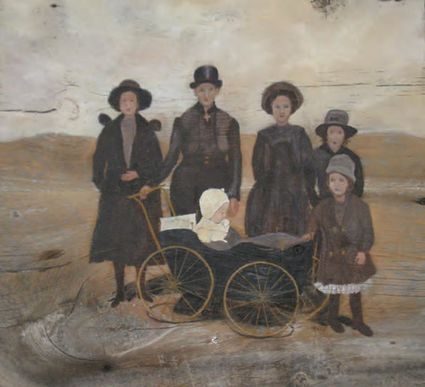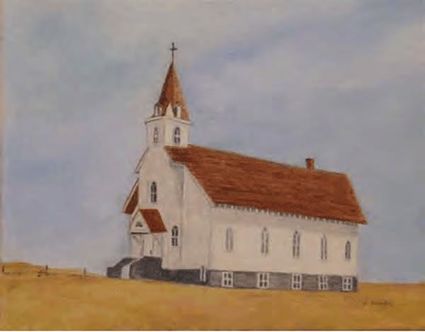SIDNEY AND PARTS EAST
Ja, De Elsket Dette Landet – Borg Ranch
May 13, 2020
No, no, it's not bad type-setting or that your reporters had a fit; we shall explain.
The initial phrase of Norway's National Song is, "Ja, vi elsker dette landet," which means, "Yes, we love this nation," and they imply Norway, of course. We modified the Norwegian a little to give, "Yes, they loved this nation," and we mean the United States, because this article and the next one, concern Norwegian immigrants that grew to love their new country, the USA.
"The Prairie Princess," a striking painting made to resemble an old photograph, addresses a single child, the baby, naturally, but her parents brought us quite a handful of new citizens.
Where were you on Christmas Day, 1889? Forgot, huh? Well, on that day Gunda Mellumbraaten was born in Norway. Losing her mother while still a baby, herself, she was raised by her aunt and uncle. At sixteen she fell in love with Lars Saterbakken, and their marriage a year later would prove one of the most fruitful in the annals of the world. He had saved every scrap of money in order to make the journey to claim a homestead in America, but his father decreed that his travel fund must be used by the eldest son, so his brother went to America, and Lars would work years more to earn another passage.
During this time he built his wife a fine home, even with stained glass windows. Eight children were born in that house Lars built for them, though two died in infancy, and that was only the beginning. He was fond of his house and called it "Borg," meaning castle. In fact, he liked it so well he decided to take "Borg" as his surname, which change was quite legal in Norway at the time and certainly saved much space and confusion in the spelling of his name in America.
One of his many occupations in Norway was driving a bus, and this made such an impression on him, he vowed never to own a motor vehicle. He was true to his pledge; he never did. While his descendants came to own cars and motorcycles, Lars abstained throughout his life.
When they were nearly financially able, they sold their home for a handsome price, which is how he financed the migration to America. Luckily for him, there were no other siblings needing ticket money. So that they would not be thought penniless, he took his wife on a preliminary shopping trip to England and bought her a coat, stole and hat of beaver fur.
In 1911, when Gunda was still just 22, husband, wife, and the six surviving children embarked in a small cattle boat making its return from Norway to Liverpool, England. The plan was that the ship took cows to Norway and brought people back, but the Borgs would have been forgiven for guessing the company had it backwards. As voyages go, this one was superior to the "Titanic's," certainly, but a storm broke their portholes, and they endured a foot of water in their cabin.
Their plan was to catch a passenger ship from Liverpool to America, where she had one brother and he, two, but that craft, damaged by the same storm, was unable to sail. As an alternative, but devious, route, they found a ship to Quebec, thence a train to Sault St. Marie, and finally entered the U.S. One suspects the family wanted badly to come here.
Lars worked as a carpenter in Minnesota, where another daughter was born, until in 1913 they were able to move to Montana, first to Sidney, then to the Fairview area. There they assumed the homestead of Gunda's brother, by then deceased. Housing–wise the family dropped several pegs, and before Lars could build again, the family dwelled in a sod dug-out.
In natural beauty, such as mountains, fjords, and forests, eastern Montana was no match for Norway, and the family missed those attributes. One wonders why people would make arduous transitions to places they admired less than home. Perhaps the advertising had been misleading, or possibly the lure was one of economic potential, but over the years many of this extended family of immigrants and their offspring would drift west to Oregon, which geography pleased them more.
Neither was their introduction to American agriculture stunning. Drought, hail, and grasshoppers, enemies to this day, thwarted Lars' crops through six years of bank indebtedness. In the seventh he told his banker to take the farm, but the banker didn't want it! Instead, he staked him to a seventh year, which proved to be a lucky number. Crops were so lush that year, that he was able to pay off the loan and the tax bills. One year there was so much grain, they lacked granary space to contain it, so the resourceful Lars boarded off part of the living room, and they stored it there.
The Borgs were no less prolific in Montana, where six more children were born. The Princess of Jane's painting, Edith, arrived in October, 1920, when Gunda still was but 31. Neither was she finished, for Nellie came four years later.
The scene shows little Edith's royal retinue, the feminine portion of the family, which had paused in the half-mile walk home from the Four-Mile Scandinavian Lutheran Church. Along with Mother, Gunda, the young ladies were Gerda, Thyra, Anna, and Ruth. Princess Edith's stylish attire was surely hand-made by her mother, while the regal carriage must have been crafted by Dad.
Indeed, Dad could do most anything. He fulfilled the role of midwife for Gunda, which honestly seems only fair for the one that brought on the condition, and delivered all 15 of their children. He was also doctor and dentist for the family, not to mention for the neighbors, and was capable of stitching up wounds and extracting teeth. To be sure, Gunda was no less versatile and was remembered rocking a cradle with a foot, nestling another little one in her lap, and knitting or crocheting simultaneously.
Though their Church has a very long official title, we affectionately call it "Sylvia's Church." Located outside Fairview, it was originally constructed in 1910, though the inside was not complete until 1917. Services were held in Norwegian every other week, with the minister's handling two other churches, as well. Unfortunately, it burned to the ground in 1926 but was immediately rebuilt. Her Church was the second.
With the passage of years, children lost facility with their parents' languages, fewer of the congregation understood them, and services switched to English. Sylvia Borg Kjos, whose father, Leif, was a son of Lars and Gunda born in Norway, grew up one of those Americanized Norwegians and remembers being taught the native hymns, which she energetically sang in duets with another parishioner, Sonja Jacobson Tomalino, (not just Norwegians moved there). Neither understood what they were singing, but they did vigorous service to the tongue of their ancestors.
The Church had no well, and toilets were two outhouses behind it. Baptismal water was brought in a Thermos bottle, and when someone forgot that on one Sunday, several people quietly drained a Model T's radiator, and the minister used that. Afterwards, the water was replaced, and neither Ford nor new Lutheran suffered from the substitution.
The congregation was separated by sex, and luckily, in those days, there was no need of an "undecided" or "variable" section; men on one side of the church, women, on the other. Once a visiting family attended and, unaware of seating etiquette, violated the segregation rule, which occasioned much staring from both the visitors and the regulars. Communion was not a common part of a service, and when it was to be distributed, those wishing to receive had to visit the minister privately beforehand. The church was electrified only in 1950, just four years before it closed. It had gas lights, but since all the services were in daylight, no one remembers them ever used.
In 1925 Leonard Thorbjornson was the first person baptized in Sylvia's Church, and in 1954 his son, Larry, was the last. Roads had improved – which may come as a shock to Musselshell County residents – as had vehicles, and farms had become larger, so fewer people lived rurally, and those that remained attended church in Fairview. The structure was sold, dismantled, and hauled away, but in 1969, in the parish cemetery, the former congregation built a native stone monument to their beloved church. The base of it contains the cornerstone and the weather vane from the 1910 church.
As with other areas of our State, we contacted local museums and others to find residents that remember the history of the area we were researching. That is how we met Sylvia Borg Kjos and her husband, Genhard. At our first visit we sat around their kitchen table eating chocolate-covered doughnuts and discussing not only the past but the present. They were in the process of transitioning their ranch to their son, so that, for health issues, they could move into her deceased parents', Leif and Doris Borg's, house in town. This, a Herculean project, due to having to sort through not only their life mementos and choosing which to keep, but also her parents' and grandparents' things and upgrading that house.
Sylvia brought out old family photos, discussed which she would like to display as paintings in their new abode, and her descriptions and stories vividly gave life to all those in the photographs. The Scandinavian Lutheran Church seemed to be the most urgent painting, though at the time we did not understand why.
Along with losing clear vision in one of her eyes, those vague health issues included a large, cancerous growth in her abdomen, which surgery the doctors were not certain she would survive, much less the needed chemo afterwards. As the days passed into weeks filled with her medical appointments, the painting of her dear church was completed, and she requested we, along with it, join their family at the Billings hospital.
As soon as she was clearly awake, she pushed the nurse's button and requested a nail and a hammer, so Genhard could hang it within her sight from her bed. There it hung, and she watched it through her long and painful hospital convalescence. The doctors insisted on chemo afterwards, but she firmly declined by saying all the cancer had been removed and that chemotherapy only would weaken her. Now, many years later, our friendship is still intact, and despite other health problems for that kind couple, the cancer has never returned. The painting is still prominently displayed in her home, and that is why we title it, "Sylvia's Church."
Enough land to make farming a full-time occupation – no bus driving and carpentry to make ends meet – was the key that brought their forebears to the United States over a century ago. Farming remains the life and breath of the family, though methodologies have changed. Lars and Gunda's great-grandson farms their former land in the no-till progressive way. Everything is seeded without leaving half the acreage in summer fallow, and the technique conserves moisture.
However, the farm does not support his family of five, and he must hold a full-time town job as well. Thus, he has completed a circle beginning with his great-grandfather's motivation to leave his home country, but now there is nowhere remaining for a young farmer to migrate.








Reader Comments(0)